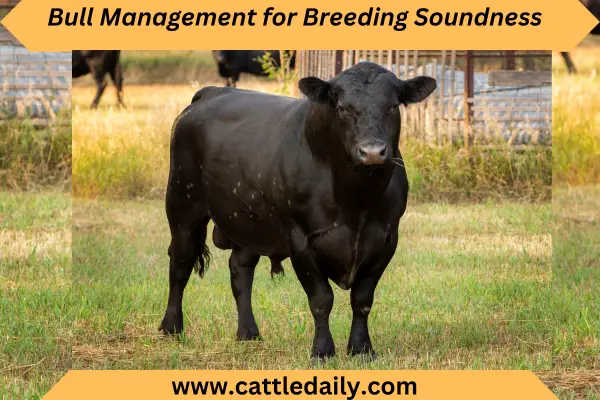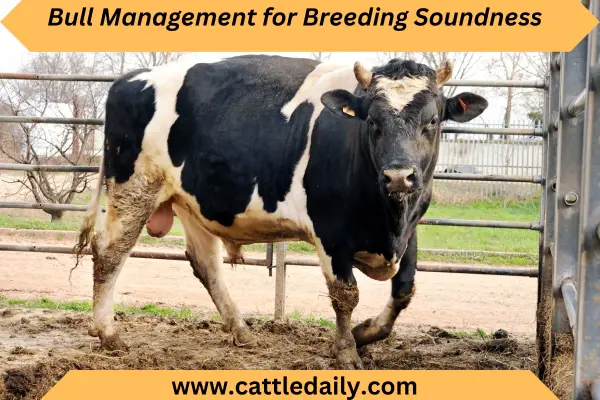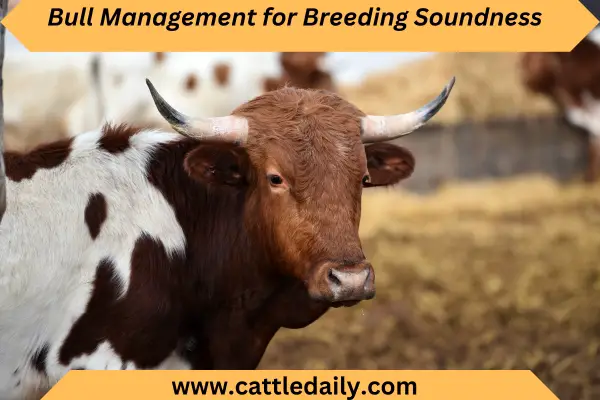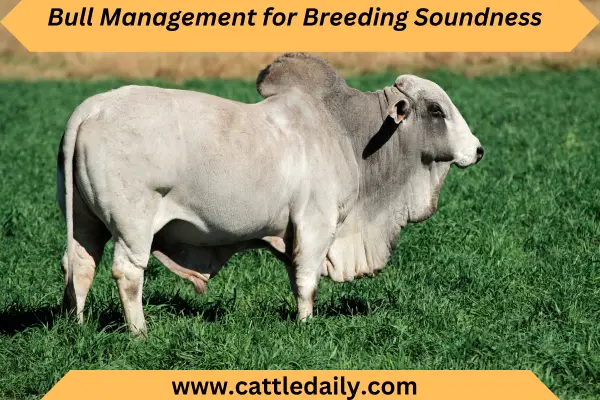Bull Management for Breeding Soundness
Selecting genetically superior bulls and managing them properly is crucial for ensuring breeding soundness and reproductive efficiency in cattle herds.
Proper bull management involves evaluating bulls for fertility and providing optimal nutrition, housing, and health care.
In this comprehensive approach helps maintain bulls in peak physical condition for sustaining breeding ability and fertility.
Importance of Breeding Soundness in Bulls
Breeding soundness examinations (BSEs) help assess a bull’s fitness for breeding by evaluating physical and reproductive parameters. Soundness issues like low sperm quality, inadequate libido, and physical abnormalities can negatively impact conception rates.
Studies show that over 20% of bulls may fail their initial BSE. Using subfertile bulls leads to significant economic losses through reduced calving percentages and culling open cows. Ensuring bulls pass their BSEs before each breeding season is vital.

Key Factors Impacting Bull Fertility
Several intrinsic and extrinsic factors can affect bull fertility and must be managed appropriately.
Age
Younger bulls have lower fertility than mature bulls. Bulls under 2 years of age tend to have inadequate libido and poor semen quality. Older bulls above 10 years of age may experience declining semen quality and fertility. The optimal age for peak fertility in bulls ranges from 3-7 years.
Nutrition
Providing balanced rations is essential for bulls to achieve puberty early, gain optimal body condition, and enhance fertility. Key nutritional factors include adequate energy, protein, minerals like phosphorus, zinc and selenium, and vitamins A, D, and E.
Housing and Exercise
Insufficient exercise and housing bulls on hard, abrasive surfaces can affect breeding ability. Bulls need space for exercise to develop musculature supporting breeding activity. Soft bedding and housing bulls away from other bulls prevents injuries impacting breeding.
Genetics
Genetic defects causing poor semen quality can be passed from bull to offspring, reducing herd fertility. Screening bulls for genetic issues using tests like scrotal palpation and semen analysis helps avoid such problems.
Disease
Diseases like brucellosis and tuberculosis cause sterility in bulls. Vaccination, isolation of infected animals, and testing ensure bull health. Footrot and lameness also impact a bull’s libido and ability to mount cows.
Heat Stress
Heat stress impairs sperm production and quality. Providing shade, ventilation, and cooling systems helps bulls cope with heat stress during hot weather.

Best Practices for Managing Bulls
Follow these proven tips for optimal bull management and fertility:
Rigorous Selection
- Purchase bulls from reputable breeders with extensive performance data on ancestors. This helps ensure you select bulls from lines with proven fertility and transmitting ability.
- Select bulls from dams with excellent reproductive histories. Dams with good calving records demonstrate fertility that bulls can inherit.
- Perform breeding soundness evaluations before purchasing bulls. BSEs assess physical health, scrotal development, semen quality and serving capacity to identify subfertile bulls.
- Choose bulls with optimal scrotal circumference based on age. Minimum scrotal sizes indicate normal testicular development and sperm production.
- Avoid bulls with anatomical defects and inferior semen quality. Physical abnormalities and low motile sperm concentration, morphology, etc. indicate subfertility.
Provide Adequate Nutrition
- Test bulls’ body condition score and design appropriate diets. Ensures diets provide adequate calories and nutrients for health and fertility.
- Feed balanced rations providing sufficient energy, protein, vitamins and minerals. Deficiencies and toxicity impair sperm production and quality.
- Supply fresh clean water at all times. Allows bulls to consume sufficient water daily for optimum semen production.
- Adjust feed quantities during high activity periods. Increased nutrition protects muscle health and stamina for active breeding.
- Provide mineral supplements if deficient. Minerals like selenium and zinc are essential for testicular function and semen quality.
Ensure Proper Housing
- House bulls separately from cows when not breeding to prevent fatigue. Allows sufficient rest between breeding sessions.
- Ensure housing prevents injury from fighting other bulls. Eliminates risk of injuries impacting breeding ability.
- Provide space for exercise and developing muscularity. Allows building stamina and fitness for serve cows.
- Use soft bedding to avoid hoof and leg issues. Prevents lameness impairing ability to mount and breed.
- Ensure good ventilation and shade. Reduces heat stress affecting sperm production during hot weather.
Allow Sufficient Rest Between Breeding
- Limit each bull’s breeding to no more than 4 cows a week during peak season. Prevents overexertion compromising libido and semen quality.
- Rotate bulls so each gets 1-2 days rest between breeding days. Ensures recovery of fitness and sperm reserves between breeding days.
- Avoid using young bulls for excessive breeding. Immature bulls tire easily and need longer rest periods.
- Isolate bulls showing signs of fatigue. Allows recuperation so breeding ability is not permanently affected.
Perform Regular Veterinary Checks
- Test annually for infectious diseases causing infertility. Ensures bulls are free of venereal diseases, brucellosis, etc.
- Check feet, legs, vision, etc. to identify problems early. Allows treatment before conditions become severe.
- Conduct annual breeding soundness evaluations. Assesses reproductive fitness regularly to detect issues promptly.
- Provide vaccines and prompt treatment if issues arise. Prevents the spread of diseases and maintains fertility during sickness.

Other tips for bull management for breeding soundness
Avoid Exposure to Temperature Extremes
Bulls are susceptible to heat and cold stress, which can impair sperm production and fertility. Ensure housing allows bulls to stay cool in summer and warm in winter. Provide shade, fans, and misters during hot weather. In winter, protect bulls from wind, precipitation, and extreme cold.
Provide Access to Clean Water
Dehydration negatively affects semen quality and libido. Supply fresh, clean drinking water at all times to support reproductive function. Water requirements depend on diet, size, and activity level. Lactating bulls need more water.
Monitor Bulls for Health Issues
Catching illnesses and injuries early improves treatment outcomes. Observe bulls daily for signs like lameness, lethargy, appetite changes, etc. monitor body condition score and watch for weight loss. Checking eyes, feet, legs, etc. helps detect problems impacting breeding ability.
Isolate Sick or Injured Bulls
Separating unhealthy bulls prevents disease spread and allows rest without competition for feed. Consult a vet for diagnosis and treatment. Return bulls to the herd once recovery is complete. Cull bulls with chronic issues compromising reproductive ability.
Treat Health Issues Promptly
Timely treatment of infections, injuries, and other health problems ensures bulls recover completely. Follow vet instructions for medications, care of wounds, provisions for recuperation etc. Provide extra feed and care to help bulls regain health and return to full vigor.
Proper preventive care and prompt treatment of health problems helps maintain bulls in peak physical shape for optimal reproductive performance.
Conclusion:
Breeding soundness is the cornerstone of profitable cattle operations, underpinning conception rates and herd productivity. While genetics provide the base, optimal fertility hinges greatly on scientific bull management encompassing selection, diet, housing, rest, and veterinary care.
Investing in quality bulls and maintaining them in peak physical condition through a comprehensive management program pays long-term dividends via improved reproductive efficiency. As the adage goes, “The bull is half your herd.”
Dedicate due diligence to these half-ton herd sires, and they will rise to meet the breeding challenges with virility, stamina, and an enduring capacity to sire endless generations of robust calves. Learn here more about cattle reproduction tips and guidance.


